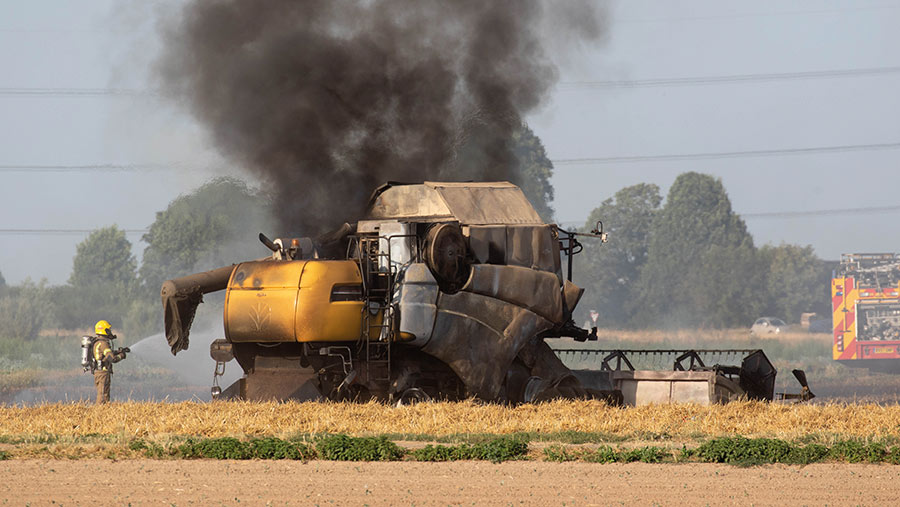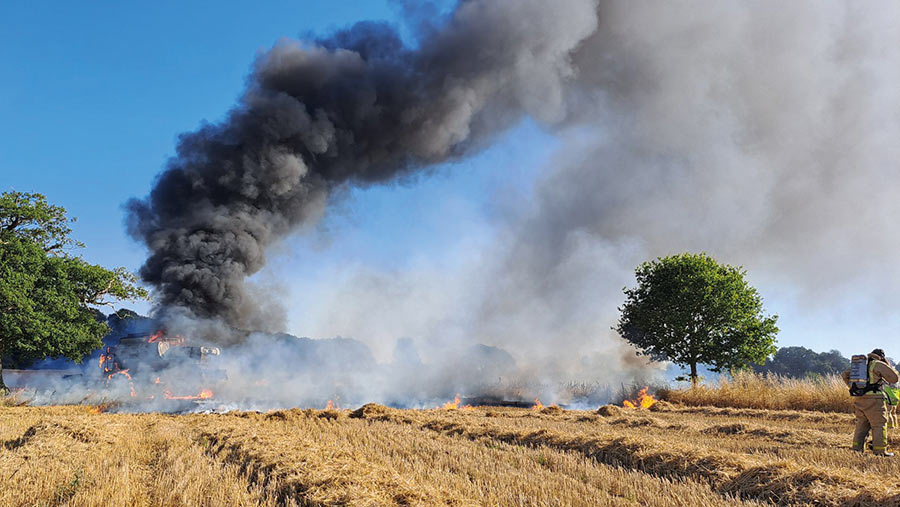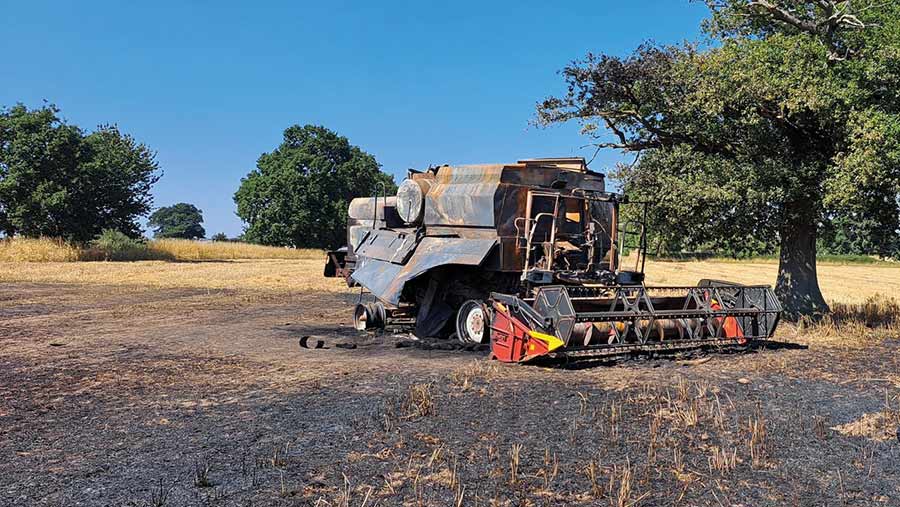More than 800 machinery fires ablaze this harvest
 © Tim Scrivener
© Tim Scrivener Tinder-dry harvest conditions triggered more than 800 agricultural machinery fires across the UK this harvest, according to Insurance specialist NFU Mutual.
That is the equivalent of nine machines catching fire a day throughout the summer months – a significant jump from six a day reported over the same period last year.
These figures fail to include the incidence of general farm fires, which saw a further 13 fires reported a day in July and August – up from eight a day last year.
See also: Farmer Focus: Monday scorchio Tuesday scorchio Wednesday…
Scorching temperatures
In any given year, farm and agricultural machinery fires tend to peak throughout July and August, during a time when farmers are harvesting and conditions are hotter and drier than other months.
Dust, hot moving parts, electrical wiring and a tank full of diesel provide all the ingredients for a major fire, explains Andrew Chalk, rural insurance specialist at the firm.
With this year’s scorching temperatures combined with low rainfall greatly increasing the risk of fire outbreaks, the number of reports exceed those made during the same period in 2021.
According to company claims estimates, farm fires cost almost £97m in 2021 and agricultural machinery fires cost a further £37m, highlighting the extra cost the 2022 season is set to bring.
It is so important farmers review their fire safety arrangements to minimise the risk of a fire getting out of hand, continues Mr Chalk.
“Farmers should also keep in regular contact with their insurer to make sure they are fully protected if the worst happens. Prevention is the best measure,” he says.
Case study: Tim Ashton, Soulton Hall, Shropshire
Shropshire farmer Tim Ashton was one of many unlucky growers to experience a combine fire this harvest during the second week of August.
Despite cleaning down the combine with a leaf blower earlier that morning, Mr Ashton had only been harvesting his crop of winter wheat for about two hours when the machine caught alight.
“It all happened so fast. I don’t exactly know for sure, but I think something happened with the engine’s ability to keep itself cool.

© Tim Ashton
“The controls were not working properly so I got out of the combine to have a look and that’s when I saw the fire.”
He immediately reached for the fire extinguisher to tackle the flames, but it escalated quickly.
Fire break
He needed to isolate the fire fast, so retrieved the JCB telehandler he used to flatten the crop and create a fire break.
In the meantime, neighbouring farmer Anthony Ford was on the scene, cultivating a strip around the fire to form a further fire break, and the emergency services were on their way.
“I would like to publicly thank my neighbour, Anthony, who helped me contain the fire, and the emergency services, who did an amazing job. They had an excellent response crew, with three fire engines who controlled the fire and made sure no one was hurt.”
One of Mr Ashton’s main concerns was the fire spreading to the Soulton Hall’s heritage house and surrounding woodland – which he says inspired a number of Shakespeare’s plays – but thankfully the fire was contained within a few square metres.
However, by this stage the fire had reached a scale that meant complete loss of the combine, but Mr Ashton admits it could have been a lot worse.
With 60ha still left to cut, Mr Ashton says the community offered truly great help and support. A local contractor helped him finish the last of the harvest, meaning he was just three days late in finishing overall.
Reducing risk
He advises farmers to take care when harvesting and points to the real need for a fire management plan.
“Putting in a fire break plan to protect crops and the wider landscape is key to preventing fires from spreading.
“We did everything by the book as much as we could. We had the combine blown down by an independent contractor that very morning and supplied intermediate bulk containers of water on hand as we knew the risks of fire.

© Tim Ashton
“It’s really important to think about risk management and consider the possibilities of what you would do in the event of a fire. We had a partial fire in the 1990s, but nothing to this extent.”
Mr Ashton noted there were about six other combine fires a day that week in Shropshire, and the day after he lost his machine, another fire was spotted within the local area.
He hopes to work more closely with the fire brigade in the future, supporting crews with training and fire drill practises on farm to help the services with further training and development when it comes to preventing and controlling farm fires.
Safety tips when working with agricultural machines
- Ensure planned preventative maintenance is up to date and in accordance with manufacturers’ service schedules before using any machinery
- Fit a suppression system that meets P-mark status to contain, extinguish and prevent fire
- Regularly clean out dust and chaff from hot spots and check the machine over when you finish use for the day
- Use a mobile compressor to regularly blow away debris from the machine, but only do so if the exit pressure is reduced (as a guide 30psi/2.1 bar is effective at cleaning)
- Wear eye and respiratory protective gear to protect from dust and never point an airline at a person to remove dust from clothing, as there is a risk of injecting air into the skin and causing bubbles in the blood stream
- Switch off engines and ensure moving parts have stopped before clearing blockages or carrying out maintenance
- Always stop to investigate hot-running engines or bearings
- Have a plan in place in the event of fire, including a system for keeping in contact with lone workers and anyone working or living on farm
- Keep mobile phones on you at all times – it’s no use to you if it’s left in a tractor or pickup cab
- Keep a fire extinguisher on the combine and ensure it is regularly maintained
- Keep a bowser filled with water on hand, and be prepared to create a fire break in the event of a crop fire
- Use the What3Words app to help emergency services find your location easily
- Make sure drivers are aware of the locations and heights of power lines and check that you will safely pass under wires
- Remind staff to keep well-hydrated, take sufficient rest breaks and monitor for fatigue and stress

